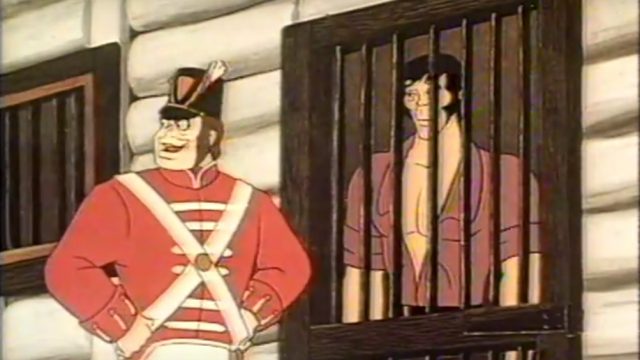The history of film animation in Australia is pretty dire. Mostly, I assume, because the resources aren’t there to produce feature length movies. Even today there’s a real dearth of local animated features. There’s a fair amount of animated shorts and cartoon ads and so on but the country’s first animated feature didn’t come until 1972’s Marco Polo Jr. (which was not a success) and there hasn’t been much since. Not long after that debut, though, in 1977 came Dot and the Kangaroo which was the first big animated success and became an intrinsic part of Australian kid culture in the eighties.
Dot and the Kangaroo was made by Yoram Gross, a pretty interesting fellow in his own right. A Polish-Jewish Holocaust survivor, he made haste to Israel soon after WWII and made a trade in documentary and newsreel camera work before finding his way to animation. In 196,1 he made Israel’s first animated feature, with the stop-motion puppetry of Joseph the Dreamer. His next movie, the comedy One Pound Only set Israel’s box office record for 1964. After the Six Day War in 1967 he decided that’s enough war for a lifetime, and moved with his family to Australia. He continued making experimental film shorts and ads until he made Dot and the Kangaroo and went on to become Australia’s premiere animator during the eighties and into the nineties.
A key to the visual appeal of Dot and the Kangaroo is in how it bypassed a lot of the cost problems of producing animated features by incorporating animated characters into live action backgrounds, laying animation cels over generic footage of native Australian bushland. At the time, Australian film in general was reckoning with colonial legacies and a burgeoning sense of non-English Australian identity that was coming through in movies like Picnic at Hanging Rock, Storm Boy, The Cars that Ate Paris, Mad Max and the Ozploitation genre. Dot and the Kangaroo presents a chipper version of those post-colonial themes for kids; one that says, sure, we can fit in here.
Dot and the Kangaroo’s a simple film but it’s sweet and it plays well with that live action/cartoon hybrid that Disney was playing with in films like Pete’s Dragon. Even though it was clearly made on the cheap, it’s charming and effective. Yoram Gross Productions decided to follow up this hit movie in 1979 with The Little Convict (or, in some markets, Toby and the Koala) a tale that’s aesthetically regressive in a bunch of ways. It trades charming character design for a shift toward ugly realism, and its story of Australia’s settlement trades whimsical storytelling for dry historical recitation. The film tries to drum up moments of excitement with pointless song sequences but they tend to have a stultifying effect on the movie.
The Little Convict opens with the live action framing device of then-beloved Australian entertainer Rolf Harris (ugh*) at a seaside carnival doing his singing schtick. He does some magic tricks and introduces himself as narrator, before holding up a drawing of a colonial-era ship that the viewer falls into like a cut-rate Dick Van Dyke in Mary Poppins. Harris is on the cartoon ship, which is part of The First Fleet – the flotilla of English convict ships that settled Australia. The ship harbours in Botany Bay and we are introduced to the characters: little urchin Toby, a bunch of gentle and caring convicts and the mean, evil policemen.
It quickly becomes apparent that the integration of live action and animation will be janky as hell. While there’s a fair bit of animated storytelling happening with cels placed over landscape footage, the Rolf Harris scenes are almost always cutaways to him without animation. He easily could have shot his parts in a couple of days. The animation quality is about that of a b-grade Hanna-Barbera cartoon, repetitious and charmless.
The story plays out like a colonial version of a Dickens story, complete with a plucky little waif and a kindly, grandfatherly pickpocket. Toby befriends a joey (baby) koala after the mean cops shoot the joey’s mother. Later he befriends an Aboriginal boy and they team up to break a convict out of jail. A governor has a Scrooge-like change of heart when he realises the goodness of the convicts and the mean old policemen get punished. I feel like a lot of research must have gone into the story and that the characters must actually be based on historical record, because everybody’s always inserting facts into conversation. This is a cartoon where everybody just talks and nothing much happens. The entertainment comes in cuts to the cute joey’s hijinks, occasional sea shanties and “funny” Irishmen.
As a dull follow-up to Dot and the Kangaroo, The Little Convict was not a success. Yoram Gross Productions went back to the well to make seven Dot sequels during the eighties. In the early nineties the studio really hit big with a film and TV series of Blinky Bill, based on the classic children’s books which are kind of like Australia’s Winnie-the-Pooh or Wind in the Willows. Gross will be remembered for these things and that’s great, because The Little Convict deserves to be forgotten.
*Let’s just take a moment here to acknowledge that Rolf Harris is a persistent presence in this movie and that’s reason enough not to watch it. For those that don’t know him, Harris was an Australian entertainer who gained international fame from the 1950s onward for his friendly songs, comedy and as a beloved TV host. He was a pop culture icon. It turns out he was also a sexual predator of children.

